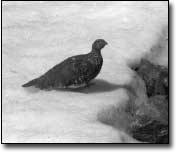|

|
|
The white-tailed ptarmigan could be one of the "losers" of global warming. The bird, which relies on cold and tundra may not be able to adapt fast enough to rising temperatures and the disappearance of vital habitat./Courtesy photo
|
by Allen Best
During summer, the hillsides above Crested Butte look like a painting by Claude Monet. Reds, yellows and blues are dabbed brilliantly on a canvas of green.
But on a small plot of land several miles away, at the old mining hamlet of Gothic, a less colorful future is foretold. There, on a knoll within the grounds of the Rocky Mountain Biological Laboratory, an experiment is being conducted that attempts to predict how global warming will change mountain meadows during the next 50 to 100 years.
The experiment is far from complete, but John Harte, a professor from the University of California at Berkeley, says it's already evident that these and many other mountain meadows will probably become less colorful in coming decades.
"Under 50 to 100 years of warming, we are likely to see our meadows looking differently," says Harte, who has been supervising the experiment for 14 years. "They will be less flower-laden, less colorful, and replaced by plants that you associate more with lower elevations, sagebrush in particular."
In other words, Crested Butte will become more like Gunnison, ski towns more like ranch towns, and upvalley more like downvalley.
At his cabin in Gothic, the Harvard-trained Harte has studied the panorama of the Colorado Rockies since 1977. Gentle and gracious, the 64-year-old Harte is by no means dour, even if his predictions are.
Harte began his experiment Jan. 4, 1991. The heat lamps he uses to warm the wildflower meadow year round had been designed for a farmer in Pennsylvania to keep chicks warm in winter. Instead of chicks, the heat filament strung 5 feet above the ground warms plants and soil. It's not glowing hot, but it runs day and night, all year.
The lamps heat the soil about 4 degrees, which is a relatively modest projection of the global warming expected later in the 21st century.
One thing Harte has found in his experiment suggests that the computer models understate the warming that could be ahead. Just as climate affects plants, plants can affect climate. The sagebrush absorbs less carbon than wildflowers, leaving more carbon dioxide in the air. More carbon dioxide causes more warming. This discovery, says Harte, "is the most exciting thing that is going on scientifically" at his experiment.
Scientifically exciting, yes, but not a happy discovery for people who love summer's colorful show of wildflowers.
Harte's experiment near Crested Butte is but one small part of the big picture now being assembled of how higher temperatures will affect mountains. Predicting changes in mountains, however, has not been easy. Computer models so far yield only broad brushes for continents. Less detail is offered for smaller areas such as the American West. Mountains, with their many weather-changing rumples, became even more a matter of conjecture. With such generalities, predictions about how the weather in Colorado's San Juan Mountains might differ from that of Yellowstone are couched in uncertainty.
"Sometimes, trying to get the details right on global warming is like trying to paint the Mona Lisa with a 4-inch house brush," says Dr. Jerry Mahlman, a climate scientist from Boulder. However, he notes that warmer temperatures is a given. And because hotter means drier, the mountains will need more precipitation to stay looking like they do now.
Already, anecdotal evidence suggests a changing climate in the Colorado Rockies. For example, the temperature at Aspen dipped below zero only seven times last winter. Global warming theory predicts warmer winters, particularly at night.
Also in Aspen, the city's Environmental Affairs Office reports that the frost-free season has expanded by 22 days since reliable record-keeping began in 1949. Most of the gain comes in spring. This fits with reports elsewhere in the Rockies that marmots are emerging from hibernation on average 23 days earlier than they did in the late 1970s. At the same time, average May temperatures increased nearly 2 degrees Fahrenheit, according to a National Academy of Sciences report.
Some evidence suggests the higher the elevation, the greater the change. Support for this theory has been found in an atrophying glacier in Wyoming's Wind River Range. There, near the summit of 13,745-foot Fremont Peak, ice cores taken from a glacier show alpine temperatures rising more than 6 degrees in the last 40 years, a rate of change far greater than that found at lower elevations.
As temperatures change, so will animals. A report in Yale's Journal of the School of Forestry & Environmental Studies tells of a study at eight national parks, including Glacier, Yellowstone and Yosemite.
In the short term, global warming means more biodiversity in these parks. However, crowding may cause the demise of some species - or worse. "There's no guarantee the ecosystem won't simply collapse," said Oswald Schmitz, Yale professor of community ecology.
While plants and animals have adapted to changed before, at issue is the projected speed of global warming. The animals and plants just won't have time to evolve. This is illustrated in a study projecting effects of global warming in Rocky Mountain National Park. While elk populations might expand if global warming produces more summer rains, white-tailed ptarmigan, an above-treeline species that is already struggling, will probably die, according to the study, which was done at Colorado State University. Warmer summers depress the success of nesting, as well as survival of adults. This species likes cold and alpine tundra.
Of course, tundra will also shrink. It would take centuries, but scientists envision vast expanses of tundra eventually being replaced by trees.
As is generally true across the world, say scientists, in the early stages of global warming there will be winners and losers. In the long term, everybody loses. ☯
|